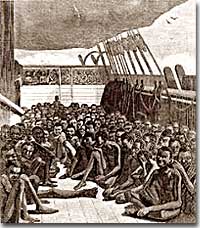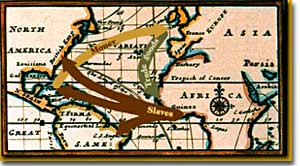6b. "The Middle Passage"

Two by two the men and women were forced beneath deck into the bowels of the slave ship.
The "packing" was done as efficiently as possible. The captives lay down on unfinished planking with virtually no room to move or breathe. Elbows and wrists will be scraped to the bone by the motion of the rough seas.
Some will die of disease, some of starvation, and some simply of despair. This was the fate of millions of West Africans across three and a half centuries of the slave trade on the voyage known as the "middle passage."
Two philosophies dominated the loading of a slave ship. "Loose packing" provided for fewer slaves per ship in the hopes that a greater percentage of the cargo would arrive alive. "Tight packing" captains believed that more slaves, despite higher casualties, would yield a greater profit at the trading block.
Doctors would inspect the slaves before purchase from the African trader to determine which individuals would most likely survive the voyage. In return, the traders would receive guns, gunpowder, rum or other sprits, textiles or trinkets.
The "middle passage," which brought the slaves from West Africa to the West Indies, might take three weeks. Unfavorable weather conditions could make the trip much longer.

The Transatlantic (Triangular) Trade involved many continents, a lot of money, some cargo and sugar, and millions of African slaves.
Slaves were fed twice daily and some captains made vain attempts to clean the hold at this time. Air holes were cut into the deck to allow the slaves breathing air, but these were closed in stormy conditions. The bodies of the dead were simply thrust overboard. And yes, there were uprisings.
Upon reaching the West Indies, the slaves were fed and cleaned in the hopes of bringing a high price on the block. Those that could not be sold were left for dead. The slaves were then transported to their final destination. It was in this unspeakable manner that between ten and twenty million Africans were introduced to the New World.






